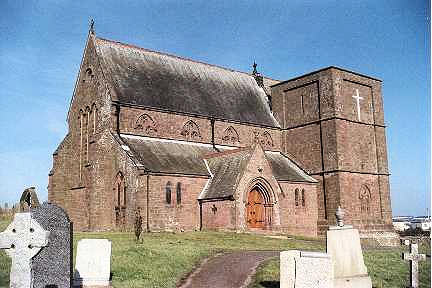Distington is a large village, chiefly consisting of one
long street of well built houses, on the high road from Whitehaven to Workington. 4½
miles N.N.E. of the former, and 4 miles S. of the latter town. There is in the village, an
edge tool manufactory, worked by Mr. Thos. Smith, and a museum, containing many
curiosities, (but not yet open to the public) the property of Mr. Joseph W. Wallace, one
of the editors of the "Manx Liberal," who occasionally resides here. About half
a mile south of the village are the venerable ruins of Hayes Castle, once the
residence of the noble families of Moresby and Distington; and is supposed to have been
the ancient manor house. The Moresby family received the manor of Distington in
exchange from Thomas Lucy, for Brackenthwaite, in Loweswater, to whom it had descended
after several generations, from Gilbert de Dundraw, son of Odard de Logis, lord of the
barony of Wigton, who lived in the reigns of Richard I and King John. Distington passed
from the Moresbys to the family of Dykes, who sold it to sir James Lowther, from whom it
descended to the earl of Lonsdale, who is now lord of the manor.
The church3 is situated on an eminence west of the
village, and is an ancient structure, consisting of a nave and chancel, a south porch, and
a bell turret with two bells. The living is a rectory, valued in the king's books
at £7 1s. 0½d. and was certified at £67 12s. 9d, but is now worth upwards of £300. The
ancient glebe belonging to the rectory is 90 acres, besides which there are nearly 600
acres of common land. The earl of Lonsdale is patron, and the Rev. Henry Lowther, M.A. is
the incumbent. Near the church is a Sunday school, erected by the parish, in 1836. There
is also in the village a Wesleyan, and a Primitive Methodist chapel, the former built in
1830, and the latter in 1838. A parochial school was erected here in 1754, but it has no
endowment, except three acres of land taken out of the common; nor are there any bequests
to the poor of this parish. The longevity of the inhabitants of Distington is remarkable.
In 1831 there were two persons, aged respectively 92 years, buried here; in 1832, one 88;
in 1833, one 86; in 1834, one 87; in 1836, one 98; in 1837, one 95; in 1839, one 86, and
one 88; and in 1840, one 86, and one 100.
Gilgarran is a hamlet 2 miles E. of Distington. The stately mansion of Capt. James Robertson Walker, R.N. is situated here; and near to the village of Distington are Prospect House, the seat of Major Henry Caldecot and Belle Vue, the residence of John Stanley, M.D.
Mannix & Whellan, History, Gazetteer and Directory of Cumberland, 1847